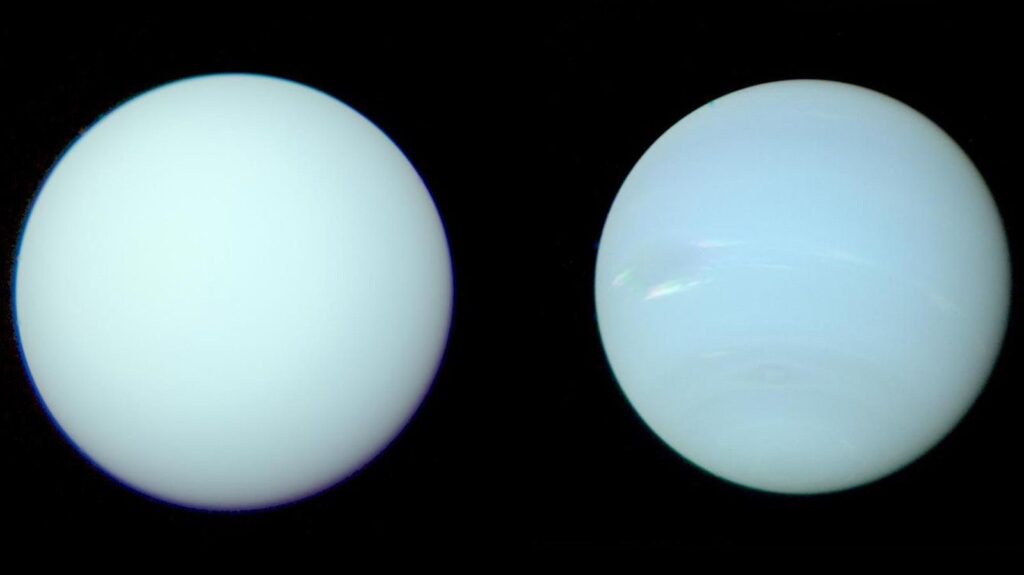The true colors of Neptune and Uranus, which frequently look in photos to have radically different hues, maybe more comparable than previously believed, according to new research.
NASA’s Voyager 2 mission, which made flybys of Uranus in 1986 and Neptune in 1989, allowed for the first up-close views of the two ice giants in the outer reaches of our solar system. The only spacecraft to pass by both worlds is still Voyager 2.
Neptune was portrayed as a vivid deep blue, while Uranus seemed to be a light shade of cyan. Each planet was photographed by Voyager 2 in a distinct color, and composites were made from the single-color photos. The white clouds and winds of the planet’s atmosphere were seen in the improved photos of Neptune.
Despite the well-known Voyager 2 images of Uranus being released in a more “true” color format, Patrick Irwin, a planetary physics professor at the University of Oxford and the author of a recent study about the images, claimed in a statement that the images of Neptune were stretched and enhanced, making them unnaturally too blue.
That distinction has faded over time, even though planetary scientists were aware of the artificially-saturated hue at the time and the photos had labels stating it.
Better color accuracy is achieved by capturing a continuous spectrum of colors using instruments like the Multi Unit Spectroscopic Explorer on the Very Large Telescope and the Imaging Spectrograph on the Hubble Space Telescope. Irwin and his group processed the original Voyager 2 photos using data that was gathered with those devices.
The retouched photos reveal that Uranus and Neptune share a similar greenish-blue colour. Although there is an atmospheric haze on both planets, Neptune’s coating is thinner, giving it a slightly bluer appearance.
Irwin stated, “We have been able to reconstitute the most accurate representation yet of the colour of both Neptune and Uranus by applying our model to the original data.”
Researchers claim that in addition to answering a long-standing query concerning the ice giants, the team’s findings and the newly discovered image, which were published on Thursday in the Monthly Notices of the Royal Astronomical Society, open the door to a deeper comprehension of the mysterious worlds.
The changing hues of Uranus
The research team took advantage of the chance to address a second planetary mystery: why Uranus appears to change colour as it round the sun, as demonstrated in the looping video below.
On Uranus, a year is equal to 84 Earth years. The globe seems greener at the summer and winter solstices, but at the equinoxes, its colour turns bluer.
During solstices, one of the planet’s poles points towards Earth and the sun because the strange world rotates on its side.
In the process of comparing the study’s photos of Uranus, the scientists examined brightness measurements of the planet taken between 1950 and 2016 at the Lowell Observatory in Arizona.
The scientists created a model to compare light data from the polar and equatorial regions, and the results showed that the polar regions reflect more light in the green and red wavelengths. This model included the addition of a methane ice “hood,” or gradually increasing haze, which is visible when the planet transitions from equinox to solstice.
We have therefore shown that the polar areas of Uranus have lower methane abundances but also higher thicknesses of brilliantly reflecting methane ice particles, which contributes to the planet’s greener appearance around the solstice, according to Irwin.
Dr. Heidi Hammel has studied the ice giants for decades.
We have been plagued for decades by our misconception of Neptune’s colour as well as Uranus’ peculiar colour variations, according to a statement from Hammel, who was not involved in the study. Both of these difficulties should be resolved at last by this thorough investigation.
Examining ice giants
The ice giants nonetheless remain shrouded in mystery. The recently released image of Uranus by the James Webb Space Telescope highlights the planet’s hidden atmospheric characteristics and rings, which are frequently undetectable.
Researchers have just discovered X-ray radiation originating from Uranus. Additionally, a peculiar “blip” in the Voyager 2 data revealed to scientists that the spacecraft had passed through a plasmoid—a massive magnetic bubble that most likely tore off a portion of the planet’s atmosphere and floated out into space.
According to research coauthor and University of Leicester planetary scientist Leigh Fletcher, a mission to explore the Uranian system—from its peculiar seasonal atmosphere to its varied collection of rings and moons—is a high priority for space agencies in the coming decades.
This kind of Earth-based research, which demonstrates how Uranus’ hue and appearance have altered over the years in reaction to the Solar System’s most bizarre seasons, will be essential for contextualizing the findings of this next trip.
